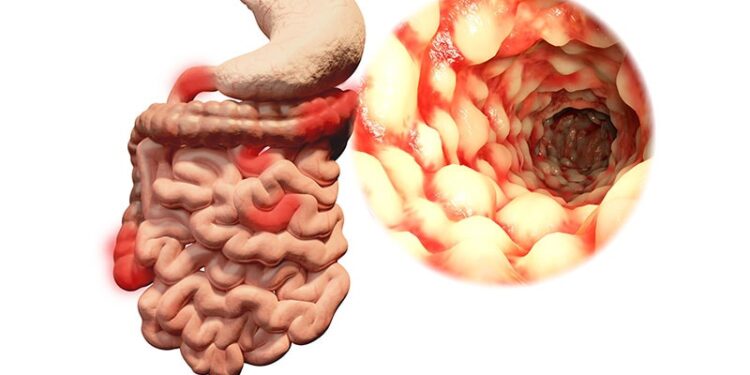Findings on intestinal ultrasound (IUS) are useful for predicting remission in recent-onset Crohn’s disease (CD), a prospective, population-based cohort of newly diagnosed patients in Denmark reported.
Adding to the growing body of evidence on the utility of this noninvasive imaging tool in monitoring disease activity in the newly diagnosed, the multicenter study published in Clinical Gastroenterology and Hepatology characterized ultrasonographic features at diagnosis and evaluated IUS’s prognostic value. Existing literature has focused on patients with long-standing disease.
Investigators led by first author Gorm R. Madsen, MD, PhD, of the Copenhagen Center for Inflammatory Bowel Disease in Children, Adolescents and Adults at Copenhagen University Hospital, observed continued improvement in most IUS parameters throughout the first year. “Our findings thereby emphasize the role of IUS in improving patient management, and its use in patient risk stratification already at diagnosis,” the investigators wrote.
Some 38% of patients reached ultrasonic transmural remission within 3 months of diagnosis, an achievement associated with higher rates of sustained steroid-free clinical remission and reduced need for treatment escalation.
“Ultrasonic transmural remission is achievable early in Crohn’s disease and is associated with favorable outcomes, underscoring the value of intestinal ultrasound in early disease management,” the researchers wrote.
Study Details
While IUS is increasingly recognized for monitoring CD, little was known about its prognostic value early in the disease course. “We aimed to determine whether sonographic inflammation at diagnosis — and particularly the achievement pftransmural remission after 3 months — could predict future outcomes,” Madsen told Medscape Medical News. “This is important, as early identification of patients at risk of surgery or treatment escalation may help guide therapy decisions more effectively.”
From May 2021 to April 2023, 201 patients (mean age, 35 years; 54.2% men) with new adult-onset CD were followed by IUS and monitored with symptomatic, biochemical, and endoscopic evaluations.
After 3 months, transmural remission was achieved more often by patients with colonic disease, and no associations were found between sonographic inflammation at diagnosis and diagnostic delay.
“We were positively surprised. Nearly 40% of newly diagnosed Crohn’s patients achieved transmural remission within 3 months — a higher proportion than seen in earlier studies, which mostly focused on long-standing or trial-selected populations,” Madsen said. “It was also striking how strongly early IUS findings predicted the need for surgery, outperforming endoscopy and biomarkers.”
In other findings, transmural remission at 3 months was significantly associated with steroid-free clinical remission at both 3 months and all subsequent follow-ups within the first year. It was also linked to a lower risk for treatment escalation during the follow-up through to 12 months: 26% vs 53% (P =.003). At 12 months, 41% had achieved transmural remission.
Higher baseline body mass index significantly reduced the likelihood of 12-month transmural remission. For overweight, the odds ratio (OR) was 0.34 (95% CI, 0.12-0.94), while for obesity, the OR was 0.16 (95% CI, 0.04-0.73).
The International Bowel Ultrasound Segmental Activity Score in the terminal ileum at diagnosis emerged as the best predictor of ileocecal resection during the first year, with an optimal threshold of 63 (area under the curve, 0.92; sensitivity, 100%; specificity, 73%).
The use of IUS has expanded considerably in the past 3 years, and in 2024, the American Gastroenterological Association updated its clinical practice guidance on the role of this modality in inflammatory bowel disease.
IUS is noninvasive, radiation-free, inexpensive, and doable at the bedside with immediate results, Madsen said. “For patients, this means less anxiety and discomfort. For healthcare systems, it enables faster clinical decisions, reduced need for endoscopy or MRI, and closer disease monitoring, particularly valuable in treat-to-target strategies.”
In terms of limitations, however, IUS is operator-dependent and consistent training is crucial, he added. “Certain anatomical regions, particularly the proximal small bowel, can be more challenging to evaluate. Additionally, while IUS is highly effective for assessing inflammatory activity, it becomes more difficult to accurately assess disease involvement when inflammation extends beyond approximately 20 cm of the small bowel.”
Key Insights
Commenting on the Danish study from a US perspective, Anna L. Silverman, MD, a gastroenterology fellow at Icahn School of Medicine at Mount Sinai in New York City, agreed the findings in adult patients with newly diagnosed, rather than long-standing, CD contribute to the growing body of evidence supporting IUS’s applicability for both treatment monitoring and prognosis.
“By focusing on early-stage CD, the study provides clearer insights into initial disease activity and response to therapy, reinforcing the value of this noninvasive, point-of-care modality,” she told Medscape Medical News. “These findings enhance our understanding of IUS as a tool to help guide early management decisions in CD.”
Ashwin Ananthakrishnan, MBBS, MPH, director of the Crohn’s and Colitis Center at Massachusetts General Hospital and an associate professor at Harvard Medical School, both in Boston, concurred that this is an important study. “It includes newly diagnosed patients — so a very ‘clean’ cohort in terms of not being influenced by confounders,” he told Medscape Medical News.
“We don’t fully know yet the best treatment target in CD, and this study highlights the importance of early transmural healing in determining outcomes at 1 year,” he noted. In addition, the study highlighted a convenient tool that can increasingly be applied at point of care in the United States. “Colonoscopy at 3 months is not practical and has low patient acceptability, so using IUS in this circumstance would have value and impact.”
Ananthakrishnan pointed to several unanswered questions, however. “Are there patients who may not have healing early but may take some extra time to achieve transmural remission, and if so, what are their outcomes? What is the best timepoint for transmural healing assessment? What is the incremental value of measuring it at 3 vs 6 months?”
In addition, he wondered, how much is the added value of IUS over clinical symptoms and/or markers such as calprotectin and C-reactive protein? “In the subset of patients with clinical and transmural remission, there was no difference in endoscopic outcomes at 1 year, so this is an unanswered question,” Ananthakrishnan said.
This study was funded by an unrestricted grant from the Novo Nordisk Foundation.
Madsen reported receiving a speaker’s fee from Tillotts. Multiple coauthors disclosed having various financial relationships with numerous private-sector companies, including Novo Nordisk. Silverman and Ananthakrishnan reported having no competing interests relevant to their comments.
Source link : https://www.medscape.com/viewarticle/intestinal-ultrasound-shows-promise-early-prognosis-crohns-2025a1000f3f?src=rss
Author :
Publish date : 2025-06-04 13:04:00
Copyright for syndicated content belongs to the linked Source.














